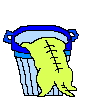Disorganized Student
Technique:
The natural ability to organize may be partly a function of individual
personality traits. Youth who do not have a natural grace for stewardship
or organization can be taught basic skills and components. The teacher,
as part of preventive discipline, can cue students about times to order
desks, prepare for the bell to ring or write down homework in a day book.
Middle school students may have a difficult time since brain imaging suggests
that the higher order centers of the early adolescent brain are in process
of change.
Procedures:
- Teach
organizational thinking and habit patterns (Covey, 1989).
- Be
proactive in thinking patterns.
- Begin
with the end in mind.
- Put
first things first - interpersonal leadership.
- Think
win/win.
- Try
first to understand,then to be understood - empathic communications.
- Synergize
- creative cooperation.
- Sharpen
the saw - balanced self-renewal (play).
- Teach
the systematic use of a day book or log
- Assignments
and due dates.
- Teach
note taking.
- Set
a time each day for organization & assisting with its acquisition.
- Model
organization in teaching and personal classroom materials.
- Teach
use of portfolio assessment and review periodically.
- Provide
organization formats for assignments. Examples follow:
- Time
log
- Mind
mapping and note taking (outlining)
- Writing
a solid paragraph
- Writing
a story
- Research
process
- Teach
self evaluation skills. Examples follow:
- Self
regulated learning
- Evaluation
of writing
- Participation
- theme evaluation

Resource for teachers:
Covey, S. R. (1989) The 7 habits of highly effective people: Powerful
lessons in personal change. New York: Simon & Schuster.
Resource for students:
Mannix, D. (1989). Be a better student. New York: Center for applied research
in education.
Once you
have completed this topic you should:
Go back to Techniques
|


















